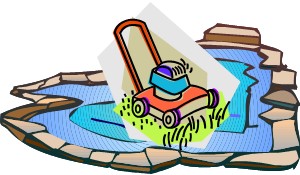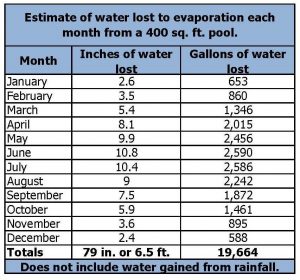Pool – Frequently Asked Questions
Due to evaporation, a swimming pool needs to be “irrigated,” just like a plot of cool-season grass with the same dimensions.

Question: How much does my pool lose to evaporation?
Answer: Pool evaporation rates can vary due to various reasons such as sunlight intensity, air and water temperature, wind, humidity, and shading. If you use a solar cover, evaporation should be almost zero. If you use a heater without a cover, it can be quite large.
The California Spa and Pool Industry Education Council estimates a half-inch to two inches of evaporation per week.
It can be estimated that a 400 square foot pool will lose approximately 19,664 gallons of water per year to evaporation.
 Note: Water features may increase water loss through evaporation and/or splash-out.
Note: Water features may increase water loss through evaporation and/or splash-out.
Question: It seems that I lose more water during dry, windy periods than during hot, humid, and still days. Why?
Answer: This is likely, as the formula for evaporation from pools has a factor for wind and another for the difference between the saturation vapor pressure (at water temp) and the actual vapor pressure (at air temp). There is more evaporation with more wind, dryer, warmer air, and warmer water temperature. The sun does not directly cause evaporation, but it indirectly increases it by warming the temperature of the water’s surface.
Following are some specific examples.
Water Temp: 85˚ Fahrenheit
Air Temp: 75˚ Fahrenheit
Relative Humidity: 66%
Wind: 0 MPH
Evaporation: 0.20 inches/day
NOTE: Wind is measured near the water surface, so it is generally lower than general wind speed.
Same as previous, but with a wind of 5 MPH: 0.62 inches/day
Save as previous, but with a wind of 10 MPH: 1.06 inches/day
Same as previous (no wind), but with a relative humidity of 20%: 0.32 inches/day
Same as previous, but with water and air temp at 55˚ Fahrenheit: 0.04 inches/day
Night & Day: The evaporation rate during the day and at night is actually somewhat similar (assuming the same wind) because the relative humidity rises at night as the temperature cools, basically keeping the same amount of water in the air. You see the evaporation effects more readily when the air is cooler since its increased saturation means there will be more visible “steam” as the water condenses.
Question: How can I tell if my pool is losing water?
Answer: It is possible for pools and other water features to leak when their equipment is running, and even leak constantly. If you want to investigate a possible leak in or around your home, first consider doing a basic meter flow check. OMWD has instructions at www.olivenhain.com/resources.
Look for visible leaks:
Many leaks associated with the pool are found in the pool equipment. Periodically turn the pool equipment on and look for visible leaks. Look for white crusty mineral deposits on pipes which could indicate a slow leak. Also, look for wet spots on the ground around the pool, pool equipment, and between the equipment and the pool.
Do a bucket test:
- The bucket test is simple. You’ll want a bucket and a wax pen. Stop manually adding water to the pool or turn off the water to the pool’s autofill until the test is complete.
- “What is an autofill?” It is a device that fills your pool with water automatically. As with skimmer baskets, autofills are typically located next to the pool inside a recessed container beneath a round lid. The autofill device is often the silent culprit for high water usage by OMWD customers.
- If you have an autofill, let’s turn off its water supply. Find the pool’s backflow device, which is usually located at the back or the side of the house. The pool’s water supply line is usually the first line out of the pool’s backflow. Turn its shut-off valve to the off position.
- Also, no splashing water out of the pool during the bucket test or backwashing the pool.
- Place a bucket or container on a pool step without submerging it, and then fill it with water to be the same level as the pool water. Use a wax marker to mark the level of the water in the pool and the level of the water in the bucket.
- Wait a minimum of two to three days to let natural evaporation occur. If it rains or it’s a windy day, you may have to redo the test. If both the levels in the pool and the bucket go down the same amount, you do not have a leak. If the water level in the pool has dropped more than the level in the bucket, you may have a leak.
- You can do a little more testing to indicate whether a leak is in the pool structure or the plumbing system.
-
- Repeat the test with the pool equipment running, or
- Repeat the test with the pool equipment manually turned off so it can’t run
If tests reveal that more water was lost with the pump running, the plumbing may be the cause. For information on pool repair, you may want to contact a professional.
What are some other tips to prevent wasting water around my pool?
- Consider using a pool cover to reduce evaporation and help keep your pool clean. A cleaner pool needs fewer chemicals and less backwashing.
- Pools seldom require draining if chemical levels are properly maintained, so consult a professional to ensure it’s necessary. Consider using water restoration systems that eliminate the need to drain the pool. Research “treating calcium without draining pools” and ask local companies for advice.
- If you have to refill your pool, read your water meter before and after filling. The difference between these reads can be multiplied by current water rates to calculate the cost of water used.
- It is possible to reuse pool water when backwashing by applying the water to the landscape. Don’t add new chemicals for 72 hours before draining so that you may use the backwash to water salt-tolerant plants such as oleanders, Bermuda grass, and natal plum.
- Minimize “splash out” by not overfilling the pool.
This FAQ sheet is meant to provide information only and is not meant to supersede your professional pool service personnel.


